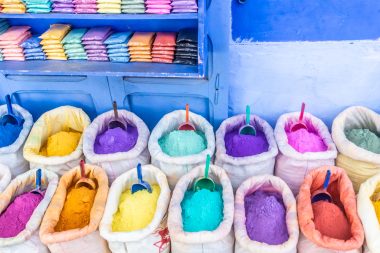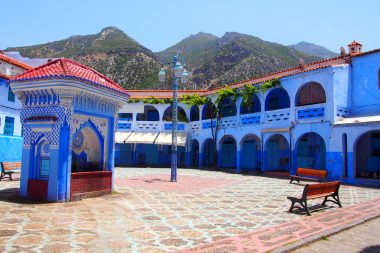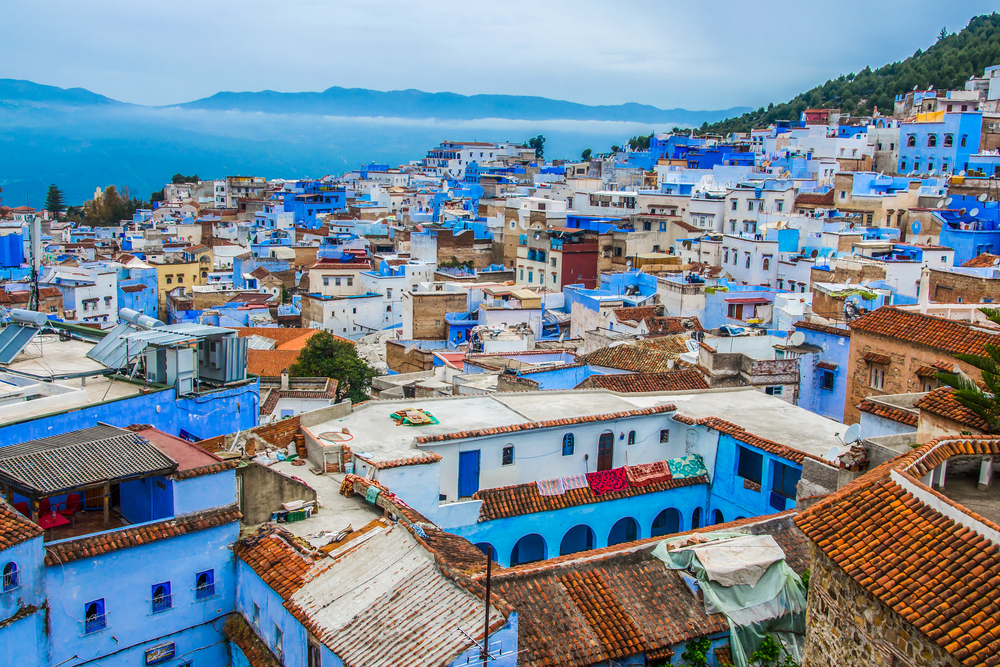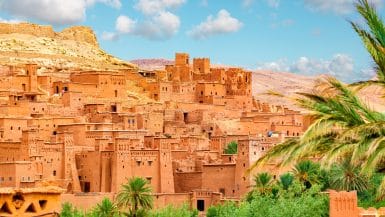Nestled in the northwestern Rif Mountains, the enchanting town of Chefchaouen is a dreamlike contrast to the typical Moroccan towns. While other cities in a dreary desert environment attract visitors with their colorful houses, colorful markets and a lively hustle and bustle, Chefchaouen presents itself as a small haven of peace in a uniquely beautiful mountain landscape. Completely wrapped in blue hues, the city looks mystical and mysterious. This is underlined by the reserved and relaxed atmosphere in the alleys.
Even though the city is more of a tip for excursions, it is worth staying in the cozy little town, which was closed to foreign travelers for centuries as Morocco’s “Holy City” and was punishable by death to enter. Not least because of this, the medieval architecture has been completely preserved to this day and a stroll through the alleys of the old town of Chefchaouen is an extremely fascinating experience, which will be remembered for a long time thanks to the special atmosphere.
The “Blue City” – Meaning of the Blue Shades

When strolling through the narrow streets of the old town of Chefchaouen, you will notice that all the houses shine in a wide variety of shades of blue. Blue is the predominant colour in the city, which has become a popular photo motif because of this. The townspeople explain the choice of colour by saying that the colour blue is supposed to protect against evil eyes and people with magical powers. This assignment of the color blue is widespread in the Orient today, but can also be found in medieval Europe. Another explanation lies in the fact that in Judaism the color blue is seen as a symbol for God and heaven and so the choice of color also seems appropriate for the “Holy City” from this point of view.
Jewish Culture and History of the “Holy City”
Chefchaouen was founded in 1471 by Moulay Ali Ben Rashid to escape the influence of the Christians, who at that time attacked numerous cities in northern Morocco on their crusades. In the course of history, numerous Moors settled in the city, which is considered sacred, and were expelled from Spain . While Jewish citizens were allowed to practice their faith in the city, Christians were denied access to the city. So it is not surprising that Jewish craftsmanship continues to be cultivated in Chefchaouen to this day. The artistic leather work of the artisans from Chefchaouen is known throughout Morocco. Walking through the old town, you will find numerous small shops selling leather and pottery as well as handmade textiles.
Sights of an extraordinary city
The charming little town in the mountains is perfect for exploring on foot. Lovingly restored, the old town shines in its varied shades of blue and makes the heart of every amateur photographer beat faster. But the impressive thing is the medieval environment paired with a unique atmosphere that is worth enjoying. The following sights of the extraordinary old town should be visited by every visitor to Chefchaouen.
Outa-el-Hammam

During a stroll through the Old Medina, the old town paved with pebbles, the steep and winding streets and the Andalusian-Arab architecture are striking. In the center of it all is Outa-el-Hammam Square, a popular meeting place. This is where the beauty of the old town culminates, as the square is surrounded by the typical old town houses and between them numerous alleys lead to the Outa-el-Hammam.
Kasbah
An excellent example of Andalusian architecture and one of the most impressive buildings in the city, the Kasbah is a point of attraction. Built in the 17th century by Pasha Ahmed Errifi, the ruler’s palace is complemented by enchanting gardens. In the gardens, the medina surrounding them seems far away. With its eleven towers, gardens and historic rooms, the Kasbah is a worthwhile destination for visitors interested in history.
Tarik Ben-Ziad Mosque
A real eye-catcher is the Tarik Ben Ziad Mosque, which dominates the city with its ornate, octagonal minaret. Those who linger on one of the café terraces can enjoy the view of the large mosque.
Folklore Museum of Chefchaouen
The Chefchaouen Folklore Museum is located in the main tower of the Kasbah. Countless exhibits showcase the city’s rich Andalusian-Arab heritage. From traditional costumes and textiles to weapons, ceramics and instruments, the Folklore Museum offers visitors a unique insight into the culture of the region.
The Reef Mountains and Targa
The reef mountains that stretch around Chefchaouen offer excellent opportunities for hiking. Here you will not only find excellent viewpoints, but also the Targa castle and mosque, which are extremely worth seeing. In addition, there are the authentic mountain villages populated by farmers, where time also seems to stand still.




